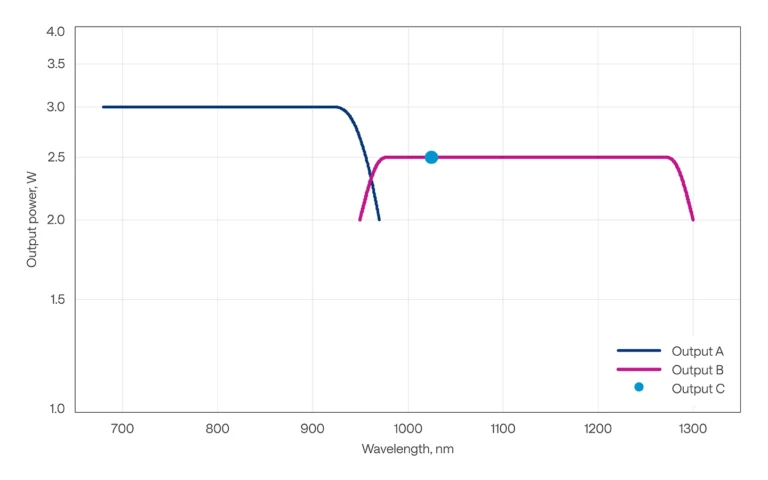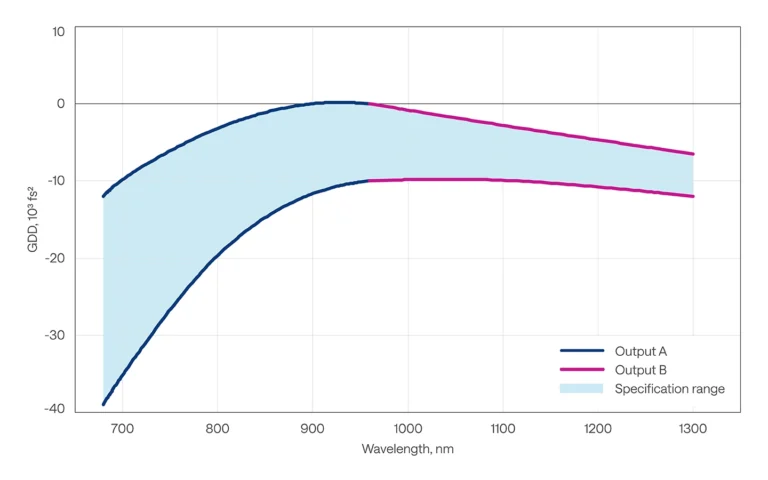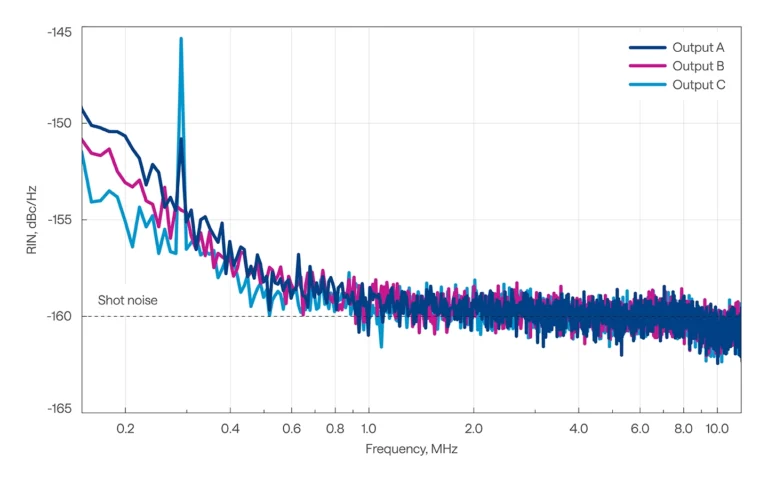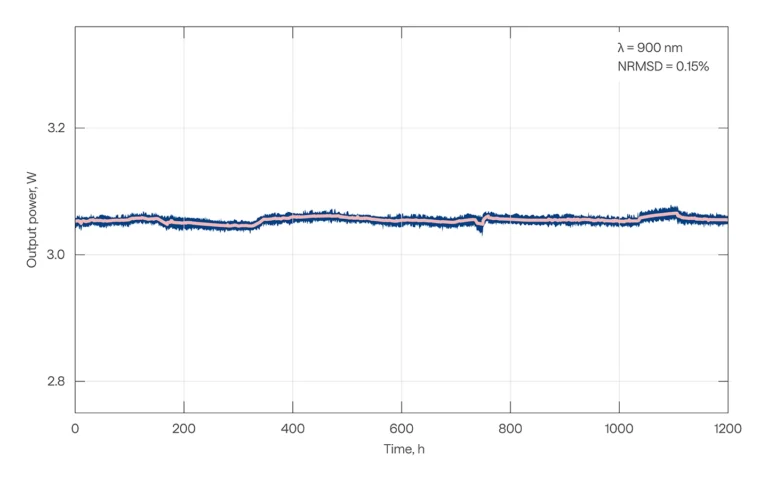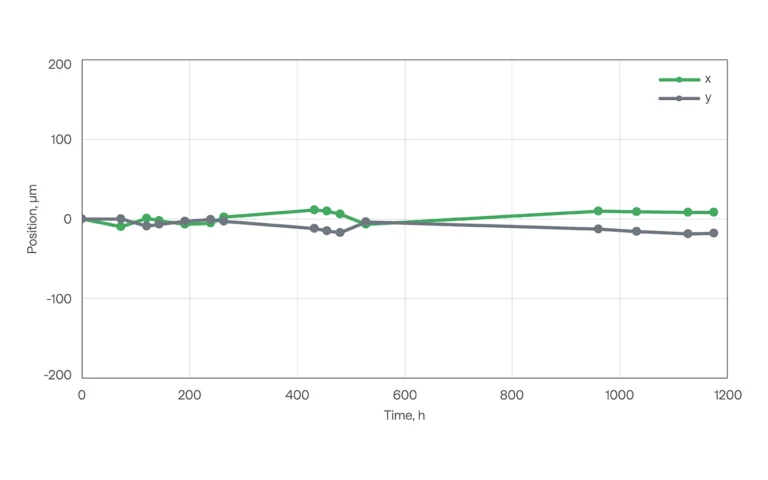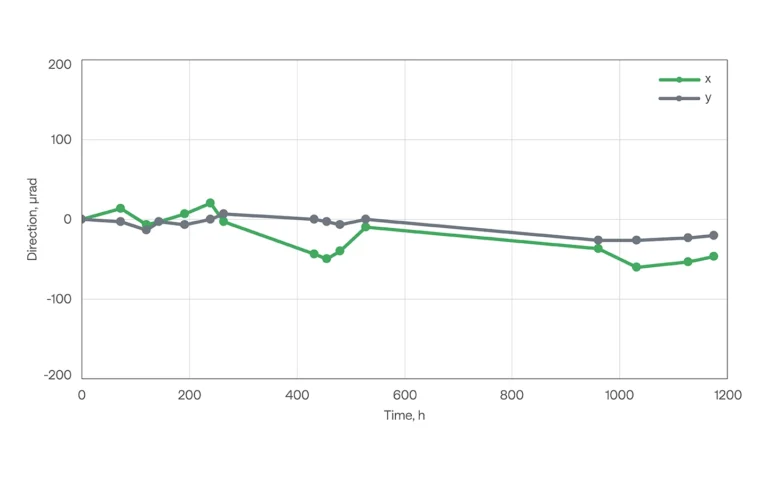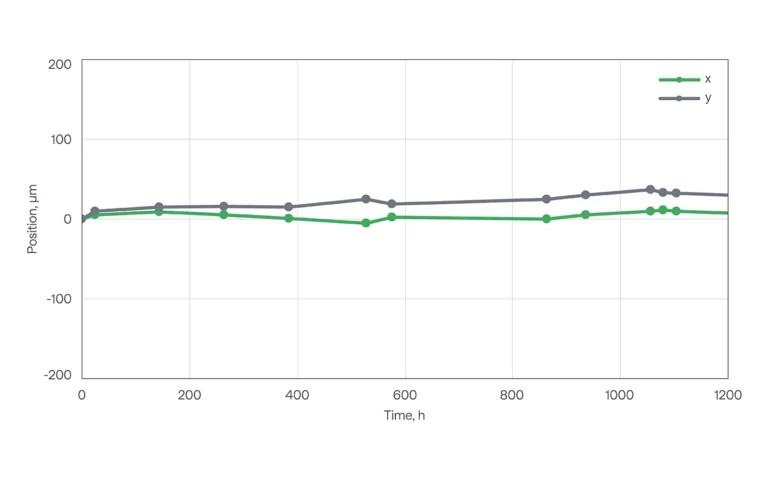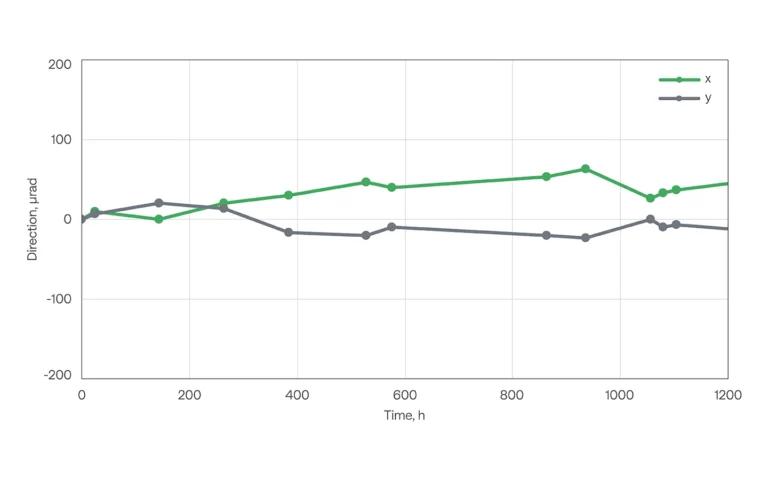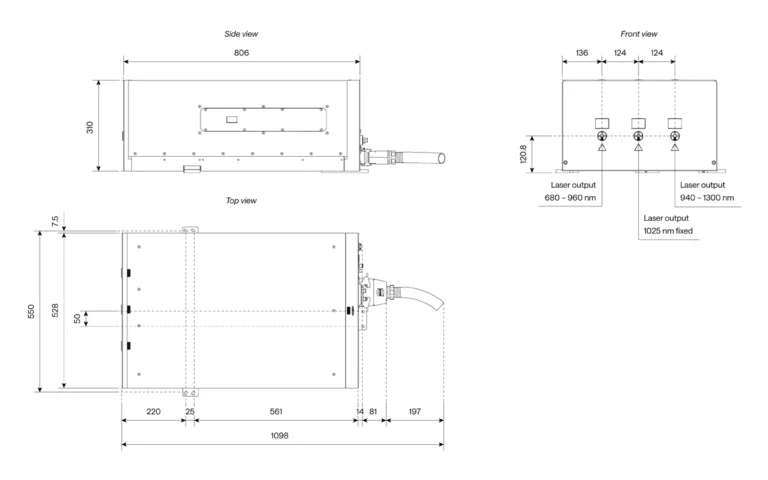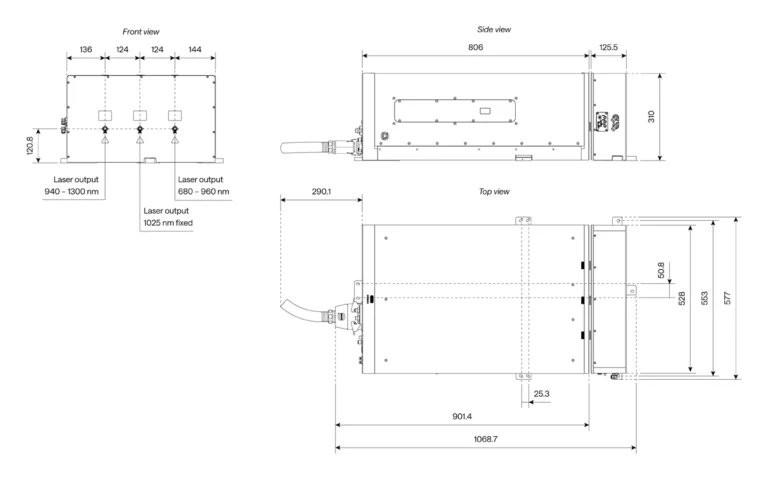Three-Channel Wavelength-Tunable Femtosecond Laser
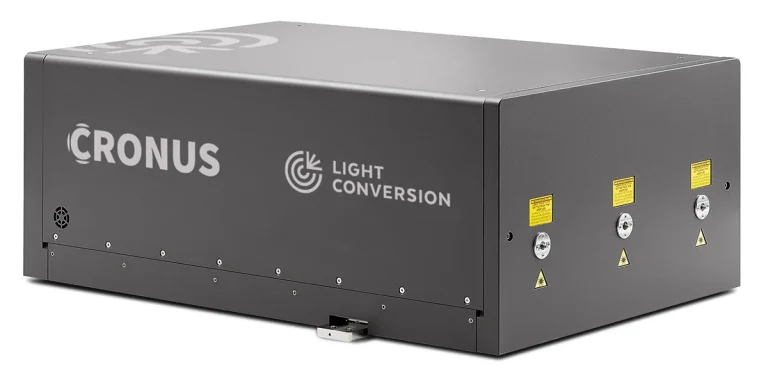
- Watt-level output at high repetition rates for fast imaging
- Two tunable and one fixed output for simultaneous multibeam excitation
- Automated GDD control for the shortest pulses at the sample
- Feedback-based output power and wavelength stabilization
- Beam steering & power locking
CRONUS-2P is a three-channel tunable femtosecond laser providing watt-level, synchronized outputs with high repetition rates, short pulse durations, and GDD control, making it the ultimate source for nonlinear microscopy. In its standard configuration, the two independently tunable outputs, which can operate separately or simultaneously, cover 680 – 960 nm and 940 – 1300 nm, respectively. The third output, fixed at 1025 nm, is accessible in parallel.
Due to this versatility, CRONUS-2P can be applied for the simultaneous excitation of multiple fluorescent probes, calcium indicators, or opsins at their absorption maxima. Additionally, second- and third‑harmonic emission (SHG and THG) can be spectrally shifted for easier detection or resonant enhancement.
The two tunable and simultaneous channels also enable advanced coherent anti-Stokes and stimulated Raman scattering (CARS and SRS) applications with dual-band imaging, a broader selection of vibrational resonance frequencies, constant-difference dual‑beam tuning, and resonant enhancement.
CRONUS-2P configurations:
- Standard: 680 – 960 nm (tunable), 940 – 1300 nm (tunable), and 1025 nm (fixed)
- Dual output A: 680 – 960 nm (tunable), 680 – 960 nm (tunable), and 1025 nm (fixed)
- Dual output B: 940 – 1300 nm (tunable), 940 – 1300 nm (tunable), and 1025 nm (fixed)
| Output A | Output B | Output C | |
|---|---|---|---|
| Tuning range 1) | 680 – 960 nm | 940 – 1300 nm | 1025 ± 10 (fixed) |
| Output power 2) 3) | > 3 W @ 920 nm | > 2.5 W @ 1100 nm | > 2.5 W |
| Pulse duration 4) 5) | < 160 fs | < 160 fs | < 160 fs |
| Pulse duration 4) 5) | < 160 fs | ||
| Repetition rate | 77 ± 1 MHz | 77 ± 1 MHz | 77 ± 1 MHz |
| Repetition rate | 77 ± 1 MHz | ||
| Beam quality, M2 3) 4) | < 1.2 | < 1.2 | < 1.2 |
| Beam quality, M2 3) 4) | < 1.2 | ||
| Polarization | Linear, horizontal | Linear, horizontal | Linear, horizontal |
| Polarization | Linear, horizontal | ||
| Beam divergence, full angle | < 1 mrad | < 1 mrad | < 1.5 mrad |
| Beam divergence, full angle | < 1 mrad | < 1.5 mrad | |
| Beam diameter 4) (1/e2) | 3.0 ± 0.4 mm | 3.2 ± 0.4 mm | 2.8 ± 0.4 mm |
| Beam ellipticity 4) | > 0.8 | > 0.8 | > 0.8 |
| Beam ellipticity 4) | > 0.8 | ||
| Beam astigmatism 4) | < 20% | < 20% | < 20% |
| Beam astigmatism 4) | < 20% | ||
| Beam pointing stability 6) | < 200 µrad | < 200 µrad | n/a |
| Beam pointing stability 6) | < 200 µrad | n/a | |
| Long-term power stability 4) 7) | < 1% | < 1% | < 1% |
| Long-term power stability 4) 7) | < 1% | ||
| GDD control range | −10 000 to −35 000 fs² @ 700 nm −3 000 to −20 000 fs² @ 800 nm 0 to −10 000 fs² @ 920 nm | 0 to −10 000 fs² @ 960 nm −3 000 to −10 000 fs² @ 1100 nm −8 000 to −12 000 fs² @ 1300 nm | n/a |
| Optional power control | |||
| Output power 8) | > 2 W @ 920 nm | > 2 W @ 1100 nm | > 1.5 W |
| Rise/fall time 9) | < 300 ns | < 300 ns | < 300 ns |
| Rise/fall time 9) | < 300 ns | ||
| Contrast ratio | 1000:1 | 1000:1 | 1000:1 |
| Contrast ratio | 1000:1 | ||
| GDD control range | 0 to −6 500 fs² @ 920 nm | 0 to −10 000 fs² @ 1100 nm | n/a |
| Optional wavelength extension (UV – VIS) | |||
| Second harmonic tuning range | 340 – 480 nm 10) | 480 – 650 nm 10) | n/a |
| Conversion efficiency at peak | 30% | 30% | n/a |
| Conversion efficiency at peak | 30% | n/a | |
| Environmental requirements | |||
| Altitude | < 2000 m | < 2000 m | < 2000 m |
| Altitude | < 2000 m | ||
| Temperature, operating | 18 – 30 °C | 18 – 30 °C | 18 – 30 °C |
| Temperature, operating | 18 – 30 °C | ||
| Temperature, storage | 10 – 35 °C | 10 – 35 °C | 10 – 35 °C |
| Temperature, storage | 10 – 35 °C | ||
| Relative humidity, operating | < 80% (non-condensing) | < 80% (non-condensing) | < 80% (non-condensing) |
| Relative humidity, operating | < 80% (non-condensing) | ||
| Dimensions | |||
| Laser head (L × W × H) | 806 × 528 × 310 mm | 806 × 528 × 310 mm | 806 × 528 × 310 mm |
| Laser head (L × W × H) | 806 × 528 × 310 mm | ||
| Power supply (L × W × H) | 378 × 445 × 178 mm | 378 × 445 × 178 mm | 378 × 445 × 178 mm |
| Power supply (L × W × H) | 378 × 445 × 178 mm | ||
| Chiller water-to-air (L × W × H) | 400 × 430 × 265 mm | 400 × 430 × 265 mm | 400 × 430 × 265 mm |
| Chiller water-to-air (L × W × H) | 400 × 430 × 265 mm | ||
| Chiller water-to-water (L × W × H) | 400 × 430 × 220 mm | 400 × 430 × 220 mm | 400 × 430 × 220 mm |
| Chiller water-to-water (L × W × H) | 400 × 430 × 220 mm | ||
| Output A | Output B | Output C |
|---|
- Configuration with dual-output A or dual-output B is also available.
- Simultaneous mode: > 1 W @ 920 nm, > 1 W @ 1100 nm, and > 2.5 W @ 1025 nm.
- Power control using AOM is applicable, see the affected specifications below.
- Specified at 920 nm, 1100 nm, and 1025 nm, respectively.
- IR pulse duration determined assuming sech2 shape.
- Beam pointing deviation over the entire tuning and GDD control range.
- Expressed as normalized root mean squared deviation (NRMSD); with less than ±1 °C temperature change after 1 h warm up.
- Simultaneous mode: > 0.7 W @ 920 nm, > 0.7 W @ 1100 nm, and > 1.5 W @ 1025 nm.
- Specified from 5% to 95%.
- Multiple second harmonic configurations are available. For more information contact sales@lightcon.com.
Product datasheet
Application examples
Product catalog
Product catalog
Product catalog in Chinese
